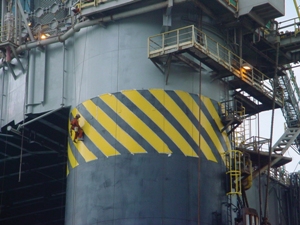Jul 9 2014
Many of the challenges faced by the offshore maintenance sector are being addressed by a breakthrough in technology from Sherwin-Williams Protective & Marine Coatings Europe, Middle East and Africa (EMEA).
 An offshore platform
An offshore platform
Acrolon 1850 is a non-isocyanate high build finish coat for exterior exposed surfaces and has been designed to meet the unique challenges faced by the offshore sector.
This sector provides a range of maintenance challenges for the coating industry such as safety colours which are used to coat offshore assets but typically give very poor opacity and coverage.
Yellow and red coatings have previously contained lead-based pigments which were cheap and offered good coverage. However because of the health & safety concerns with lead, organic pigments are now used which can be expensive with poor opacity, and numerous coats are often required to provide complete obliteration of the undercoat.
Acrylic urethanes are generally regarded as the standard topcoats for many industries, but contain isocyanates which are prohibited or undesirable in many offshore markets including the North Sea.
One of Acrolon 1850’s key benefits is the ability to achieve full coverage in a single coat by brush or spray allowing rapid return to service and reduced downtime for customers.
Other properties include strong gloss retention, good results in UV, and weathering performance to prolong service life.
Lee Spoor, oil, gas and chemical project development manager for Sherwin-Williams Protective & Marine Coatings EMEA, said: “The use of isocyanates in the North Sea offshore market is not normally possible, but this product gives those in the maintenance sector a next generation alternative, providing features that were not an option previously.
“Used in conjunction with epoxy primers and undercoats, it also has a range of benefits that will assist customers, including excellent weather resistance.”
Compared to other coatings, which can remain susceptible to water spotting for more than 48 hours following application, Acrolon 1850 is resistant to moisture in just four to six hours.